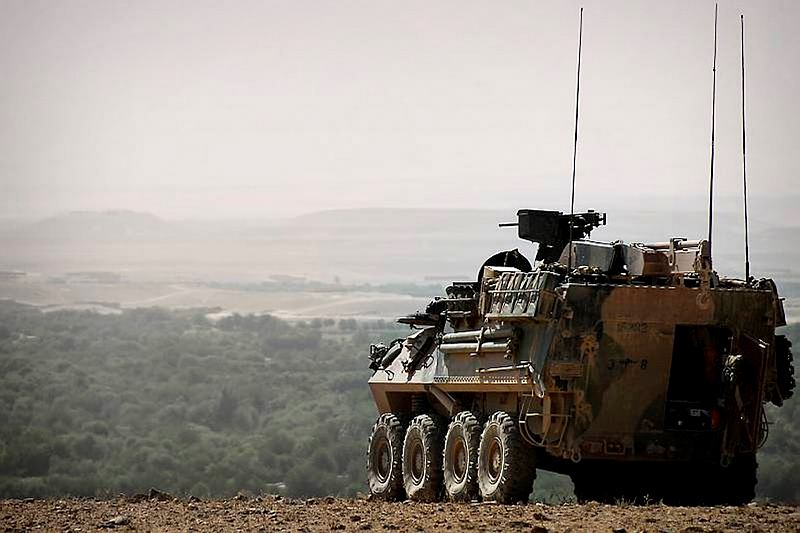
We're at the Land Forces 2014 conference this week. Even a casual glance around the floor of the associated trade show suggests immediately that there's some serious positioning going on among vehicle manufacturers to supply the Army's next generation of protected-mobility vehicles.
The prize, of course, is
Project Land 400—described by the DMO as:
...one of Defence's most significant capability programs both in terms of acquisition cost and its impact on the Army's war fighting capability. The program seeks to address the emerging mounted close combat capability gap that exists between the current in-service vehicles and increasingly capable weapons that could be used against Australian forces.
The scope of the project is essentially to replace the entire frontline fleet of Army vehicles. Australian Army's experience of operations in Afghanistan, during which improvised explosive devices were a constant source of danger, has made it an imperative to provide troops with increased protection. That will involve replacing several different fleets, including the Vietnam-era (but upgraded at much expense)
M113 tracked personnel carriers and the ASLAV light-armoured vehicles.
Land 400 is literally a big deal—the
Defence Capability Plan gives the cost as ‘more than $10 billion’ but many defence watchers and industry players assess that the total value is likely to be double that. It's big enough to be included in the DCP-distorting
'big four' projects with the F-35 and future submarines and frigates. Because of the big price tag, and
the oversubscribed DCP, it's been expected that Land 400 will be 'phased', with fleets being replaced progressively as they age out rather than a wholesale upgrade.
The most urgent replacement is the ASLAV fleet, which reaches life of type around 2021. That might seem a comfortable enough time to find the right vehicle on the world market and buy it ‘military off the shelf’ (MOTS). In fact, it'll be needed, because it's most certainly not a MOTS project—a fact we were pleased to hear recognised in today's presentations.
The days in which soldiers embarked and disembarked from a vehicle with no interaction between man and machine other than transport are long past. The Army's vehicles have to be able to work seamlessly with all of the land (and increasingly joint) information, communications and battle management systems. In other words, there's a lot of systems-integration work to do. Given the time-honoured habit of integration-heavy projects taking longer than expected, getting the requests for tender out this year, as is the plan, seems about right.
But at least the ingredients—the vehicles and the embarked systems—are all MOTS, so there's a fighting chance of getting it right. When the US Army set out to plan its Future Combat System (FCS) vehicles, it simply got too ambitious and complex. Requirements changed and caused turbulence in an already ambitious program. Eventually the Department of Defense cancelled the FCS program in 2009. While there are
specific lessons to be learned within the acquisitions community, the ADF leadership must keep those in mind during the critical phases to come.
For example, US Army leadership and FCS program directors became too hung up on unrealistic ‘requirements’ in the midst of an on-going war that increased the demand for protection and survivability. In their initial assessment, US Army leaders saw the need to get to a global crisis fast and so maintained a requirement that the vehicles be C-130 deployable, which meant they had to be light. The wars in Iraq and Afghanistan increased the need for protection and survivability, which posed an ever more difficult engineering problem—compounded by the need to integrate a complex and interoperable system of systems that didn't exist even in prototype. Adding requirements without revisiting assumptions about the needs of the future added difficulties to an ultimately insurmountable challenge. Our industries can innovate in a competitive environment, but there are limits.
ADF leadership is likely to face similar temptations and they've made sure the program comes with the caveat that they can change requirements during the process. With the Army
Future Land Warfare Report indicating a future operational environment of crowded megacities coupled with increased lethal capability from enemy forces, Army leaders are going to face a similar tension between protection and survivability on the one hand and deployability and mobility on the other. A highly-protected and survivable vehicle that can’t operate because it's too heavy for bridges or roads of rundown megacities or the poor infrastructure of nearby regional states is as worthless as a light-skinned vehicle that offers our troops only cursory protection.
Land 400 still has a long way to go but it seems headed in the right direction. A phased project based on proven vehicles and established systems isn't without risk, but it's less ambitious and less fraught than it might've been. ADF leaders will have to be decisive in finding the unhappy medium and then take the inevitable criticism years down the road. Having a good vehicle, built at reasonable cost and reasonably on time will be far better than having no vehicle at all.
Andrew Davies is senior analyst for defence capability and director of research at ASPI. Lieutenant Colonel Jan K. Gleiman is an active duty US Army officer and a visiting fellow at ASPI from United States Pacific Command. The views expressed in this post are his own. Image courtesy of Department of Defence. Print This Post
Print This Post We're at the Land Forces 2014 conference this week. Even a casual glance around the floor of the associated trade show suggests immediately that there's some serious positioning going on among vehicle manufacturers to supply the Army's next generation of protected-mobility vehicles.
We're at the Land Forces 2014 conference this week. Even a casual glance around the floor of the associated trade show suggests immediately that there's some serious positioning going on among vehicle manufacturers to supply the Army's next generation of protected-mobility vehicles.